Media | Articles
Square Peg, Round Hole: Grand Wagoneer restomod as unwilling tow rig
There comes a moment in any automotive project where expectations butt up against reality. Sometimes this occurs early on, when the sheer, terrifying scope of what has to be done stretches out in front of you like an endless sea, floating bonfires of cash glinting like beacons of despair in the distance. More often, I find, that reckoning hits hardest just after reaching a major checkpoint in the build process; it might be the initial turn of the key after an engine has been put back together, that first pass down the quarter-mile, or maybe even the reaction of your family when you finally escape the shop and park your reconstructed ride in the driveway at home.
For the past few years, I’ve been chronicling the transformation of my 1987 Jeep Grand Wagoneer here at Hagerty Media. In that time, I have guided from hidden survivor to restomod daily driver. Each step I’ve taken in that build process—from swapping in an LS engine, to replacing the gearing in the front and rear differentials, to overbuilding the cooling system, installing a hydroboost braking system, and even refurbishing the tape deck—has been with one overarching goal in mind: a cool classic SUV that would both ooze old-school charm and start every single time I needed it to.
There was also, I must admit, a practical application: towing my 1978 Datsun 280Z. I was no longer comfortable driving hundreds of miles to and from the track in my Datsun, especially while enduring the merciless summer heat. Hence the need for a tow rig, which meant adding a list of upgrades to the Grand Wagoneer that went above and beyond what might have been “strictly necessary” for a simple LS swap. All so I could hitch up and drive off into the sunset hauling ancient J-tin on a trailer behind me.
When it came time to do exactly that, I found myself face-to-face with a startling, unexpected situation—one that unveiled something about myself more than it did about the vehicle I was driving.
An Inauspicious Start
In the fall of 2022 I attempted towing with my Jeep Grand Wagoneer. I quickly discovered that the Jeep’s ancient, sagging OEM springs had trouble safely handling an unladen U-Haul trailer, let alone one transporting 2500 pounds of Datsun. By the time I had installed a full set of replacement leafs (and load-leveling airbags at the rear), track season was finished for the year, postponing a true test of the new setup until spring’s thaw.
Once April 2023 rolled around, I was raring to go. I’d spent the winter months fantasizing about how much I’d enjoy rolling down I-91, aiming at my first time trial event of the season at New Hampshire Motor Speedway. I could practically hear the Jeep’s 5.3-liter V-8 bellowing out a joyous bass note through the White Mountains, my Z securely locked into place on an affordable rental trailer of dubious quality.
Before I could even hit the highway on-ramp, the whole trip was nearly cut short. At U-Haul, the clerk wouldn’t let me leave the lot with the trailer due to a malfunctioning right-side blinker on the trailer harness. It took about three hours of detective work with the help of nearby AGM Performance (the shop that had installed the LS under the hood of my Jeep), a burned-out signal box, and several return visits to U-Haul for parts. In the end, a new harness installed under the back bumper satisfied U-Haul’s scrupulous safety mavens.
Trailer in place, I was now significantly late to met my father just on the other side of the Quebec/Vermont border, so I hurried home to load up the car. Because I live in the heart of Montreal and don’t have a long driveway, this task had to be completed street-side. Fortunately there is a school zone right out front, which is almost always free of parked cars for the seven or so Jeep-lengths I needed to line up the Z in front of the ramps.
We began to load up. Then came the second insult of the morning: the sound of screeching metal. A curled lip at the very end of the trailer gouged a valley along the Datsun’s decades-old undercoating and left a tidy pile of sadness just behind the back wheel.
A Shaky Foundation
Leaving aside the Z’s unrelated underbody gouge, there are several reasons why an ’80s Jeep Grand Wagoneer makes for a poor towing platform. Although I had taken care of most of them—the lack of power from the original AMC boat anchor engine, the somewhat sketchy nature of its factory brakes, and the tendency for its hindquarters to “wag-sag” under load—there was little I could do about its most limiting characteristic: short wheelbase.
The wheelbase of the original Grand Wagoneer checks in at 110 inches, or three feet less than what you’d find on a current-model-year pickup truck. As a result, it’s particularly sensitive to tongue weight and to the side-to-side sway of a trailer when traveling at highway speeds. Normally I would be able to make use of a load-distributing hitch to help push some of that tongue mass onto the front axles, but U-Haul trailers do not allow for that option due to the design of their surge brake system, which requires that the neck move freely. The trailers also have the propensity to pile on tongue weight via a loading strap system that requires parking the carried vehicle as close to the front of the deck as possible. Finally, there’s the pesky fact that the trailer, Datsun, and assorted gear on board combined to weigh awfully close to the Grand Wagoneer’s 5000-pound tow rating.
As soon as my fiancée and I cleared the city, it became clear to us that the Jeep was highly sensitive to any trailer movements, which might be caused by rough pavement, changes in speed, or even the lateral gravitational pull of ordinary bends in the road. Each steering input and every tap of the brake pedal invited bad behavior from the train I was conducting; I carefully policed my movements so as not to instigate any more wiggle than I could comfortably control with the Grand Wagoneer’s already nautically vague steering setup.
Once across the border, I stopped to fuel up and add air to the rear bags, increasing pressure from 60 psi to 80 psi (but still leaving 20 pounds of leeway below their theoretical maximum rating). This seemed to help somewhat with the rig’s lapsed adherence to tracking straight, and it allowed me to slightly relax the hyper-vigilant state I had assumed. Still, I watched my side mirrors and tuned in to the twist transmitted to my tuchus for any indication of impending trailer chaos.
With that issue settled to my relative satisfaction, a new, more viscous one emerged.
The 4L60E transmission yoked to my Jeep’s LS-series V-8 contains three forward speeds plus overdrive. To safely tow any appreciable load (especially over mountainous roads) it’s necessary to lock-out OD and stick with third gear, thus avoiding heat build-up and possible damage to the transmission.
The consequence of this situation was a near-constant engine drone from 2700 to 3000 rpm, depending on steepness of the road. While I could suffer the extra-loud engine noise, the seals on my motor weren’t quite as willing to. After one particularly cacophonous downshift to second gear to maintain 70 mph up a long and steep grade, the revs briefly rose past 4000 rpm. After that, I began to notice a strange speckling on the rear window. Figuring it was just accumulated dust from the road surface, I ignored it … until it began to blot out my view through the back glass.
It wasn’t until I had pulled into the entrance at the track in New Hampshire I ran a finger over the window. The dot matrix printed across the back glass was, in fact, engine oil.
Not only was the back of the Jeep covered in the stuff, but my gleaming white Datsun had also become a sullied grey-cream, coated by a slick of lubricant that would no doubt impress the officials at tech inspection the following morning.
According to the dipstick, the Jeep’s engine was down a full quart of oil, which for just a two-hour drive is quite considerable. Most of the missing 10w30 was noticeable all along the underside of the Grand Wagoneer. I was, however, unable to pinpoint the exact source; the top of the engine was completely dry, and there were no hoses, seals, or breather valves in obvious distress.
Project-Truck-As-Therapist
I’d like to be able to tell you that the trip back home was better. That once I knew what to expect from the Jeep’s sketchy towing dynamics and frightening thirst for oil, I could better deal with the stress of the entire experience. Unfortunately, that wasn’t the case. Instead, I compounded the tension of the previous day’s difficulties by berating myself for landing in this position in the first place.
I felt stupid. Stupid for having invested so much time, effort, and cash into a project that could not complete a task for which I intended it. Yes, I could deal with the engine oil leak once I had time to put the Jeep on a dyno. No, nothing catastrophic happened. But the Grand Wagoneer’s ultra-sketchy towing behavior with that U-Haul trailer was not something I’d repeat in the future. And without a distributing-hitch-friendly trailer of my own, nor space to store it, this pressed pause on any upcoming Jeep towing adventures.
Worst was the feeling that my poor decisions impacted the people I care for the most. It’s one thing to subject myself to the consequences of my contrarian ambitions (which often pushes me drive something I consider “different” or “interesting,” regardless of the pitfalls or risks). But it was quite another to I could see it in the worry lines on my father’s face when I met him at the border, hours behind schedule. Then, the evening we left to head home, he voiced his concern about whether I’d make it back safely without jackknifing, imploding, or perhaps both. I could hear it my fiancée’s voice as she tried to talk to me over the din of the near-freezing rain on a 20-mile stretch of construction work on the evening of our return. Half the trailer’s wheels were on smooth asphalt, the other half skittered crazily over a latticed surface. I gave short, terse answers to questions, leading to uncomfortable, brooding silences. I did not like surrendering control of the situation to what felt like providence.
Learning To Let Go
After some thought, I realized I’d crossed a line not just in terms of practicality and utility, but also safety and reason. I had built a square peg and tried to fit it into a round hole, only to then insist on rounding off the edges until I could push it through half-assed and sideways, taking my family with me for the ride.
Despite all of my preparations, tasking my Grand Wagoneer to pinch hit as an occasional tow rig is simply outside the scope of what its platform can comfortably handle. Yes, with the proper trailer and a more appropriate hitch, I’d likely have a better overall experience hauling my race car. But at the same time, I’m still asking a short-wheelbase SUV with a fairly low towing capacity to negotiate significant elevation changes and highway speeds that an a full-size truck wouldn’t sweat.
In nearly every other circumstance, I really enjoy the Jeep that I’ve built. It’s a fantastic long-range mile-eater, it brings smiles to the faces of everyone I meet driving it through Montreal’s city streets, it’s quite comfortable, and its generous cargo area makes it remarkably practical. By every non-towing measure, the Grand Wagoneer project has been a rousing success. After all, it looks great and it always starts.
I’m letting go of the tow-rig dream as a yardstick for this project’s success. The true failure here would be for me to ignore this lesson and double-down on trying, squeaking through another towing adventure with little to no margin for error. I didn’t expect a 40-year-old truck to teach me how to be at peace with my personal character flaws, but I’m grateful to have made it out of the experience with a better understanding of myself.
What else do I now understand? That a lightly-used, 21st-century pickup would find in my stable a welcome new home. Stay tuned!
***
Marketplace
Buy and sell classics with confidence
Check out the Hagerty Media homepage so you don’t miss a single story, or better yet, bookmark it. To get our best stories delivered right to your inbox, subscribe to our newsletters.

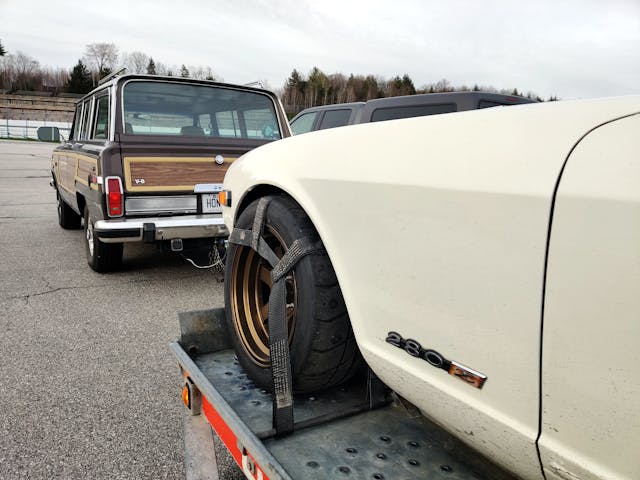
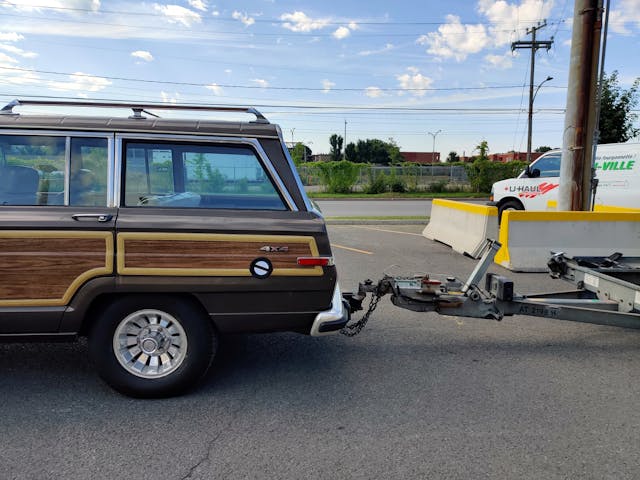
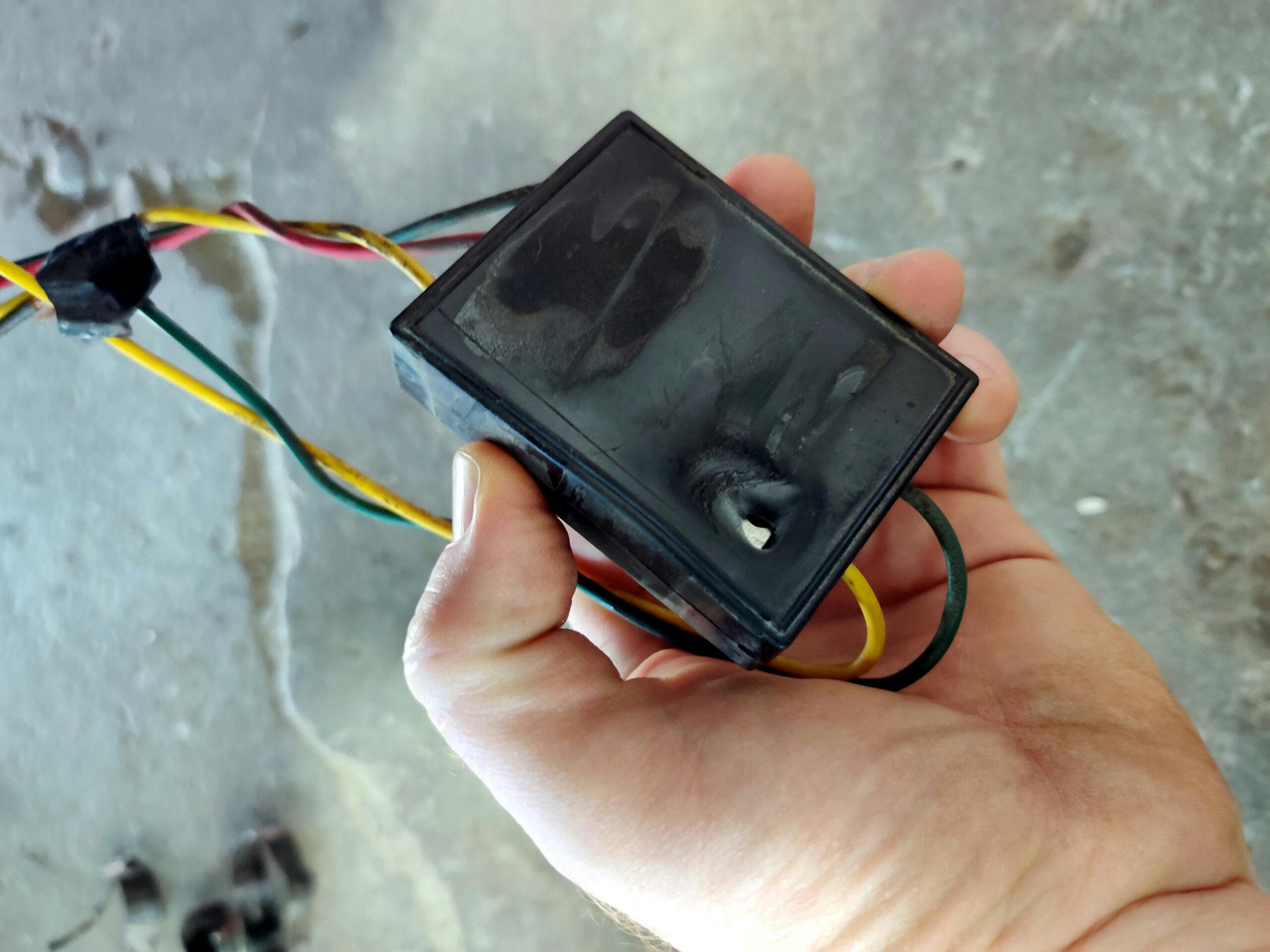
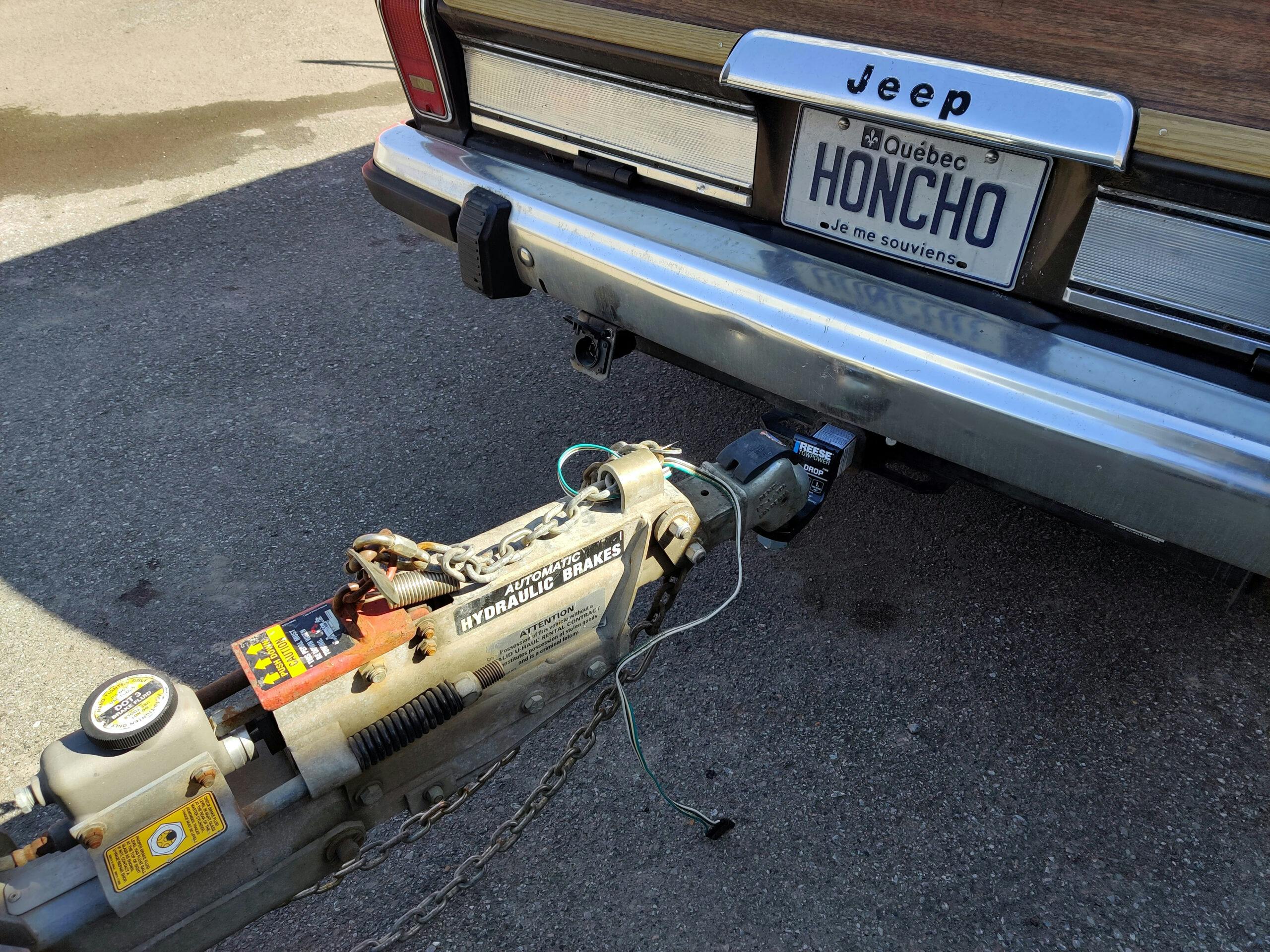
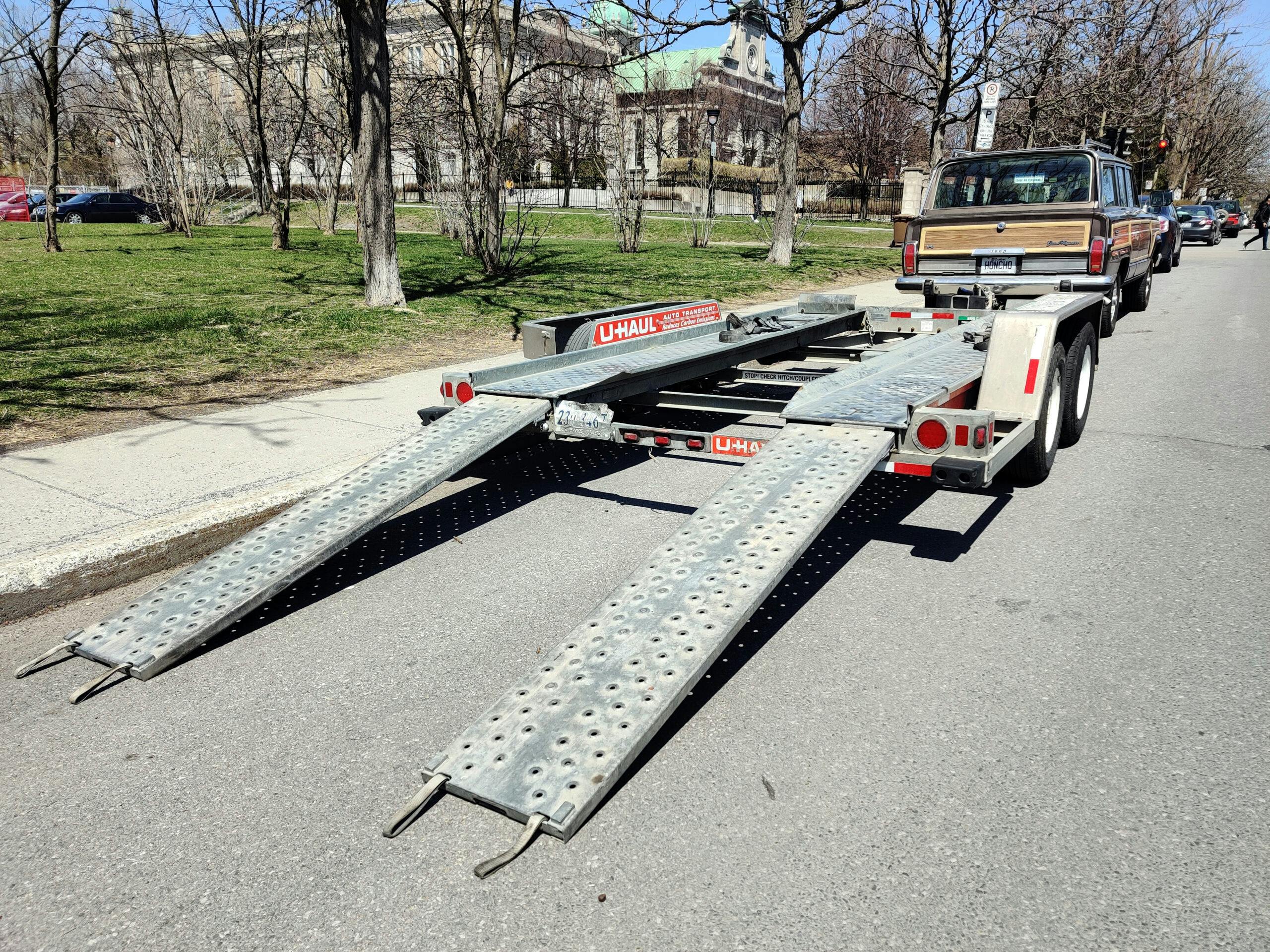
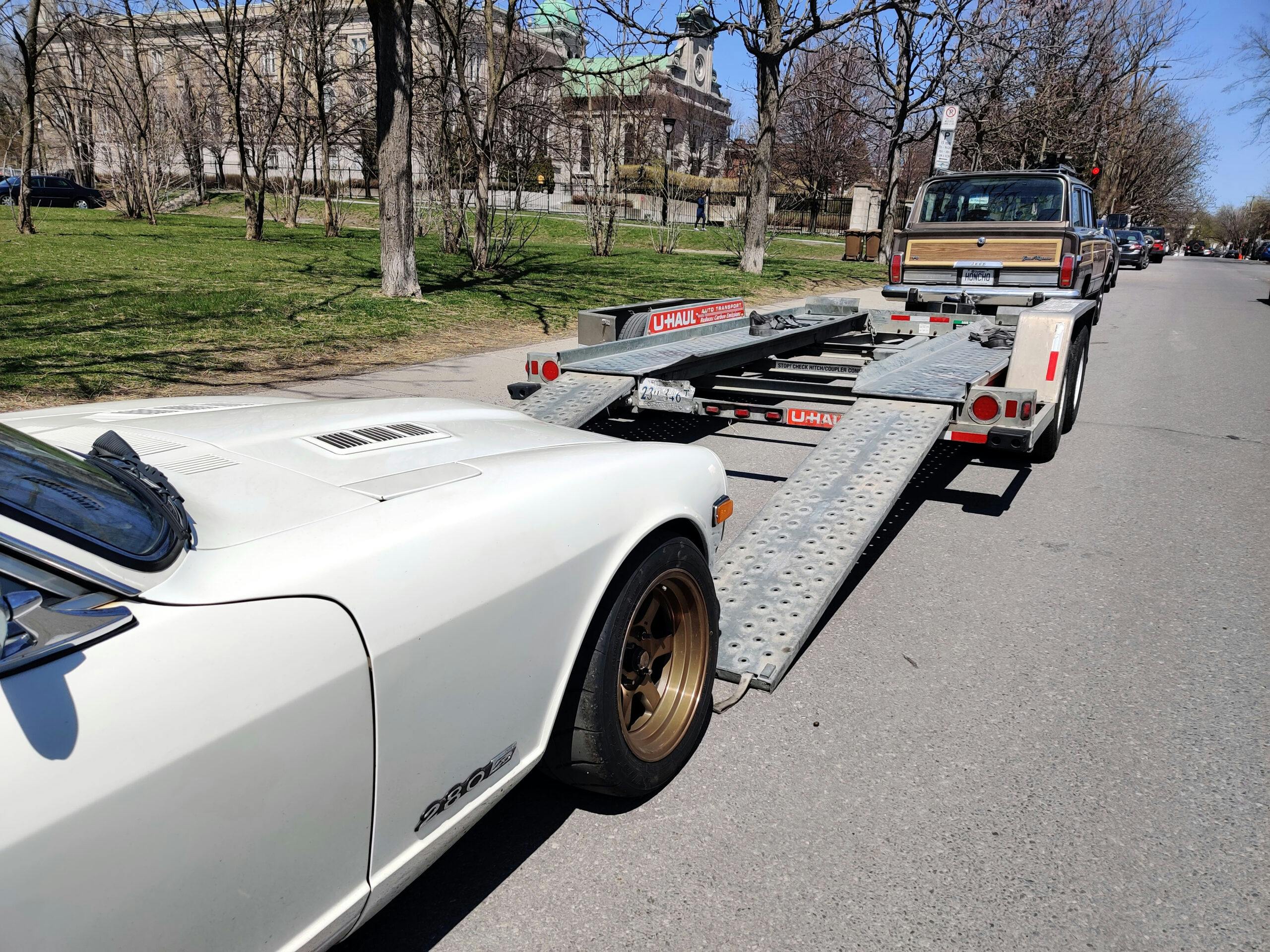
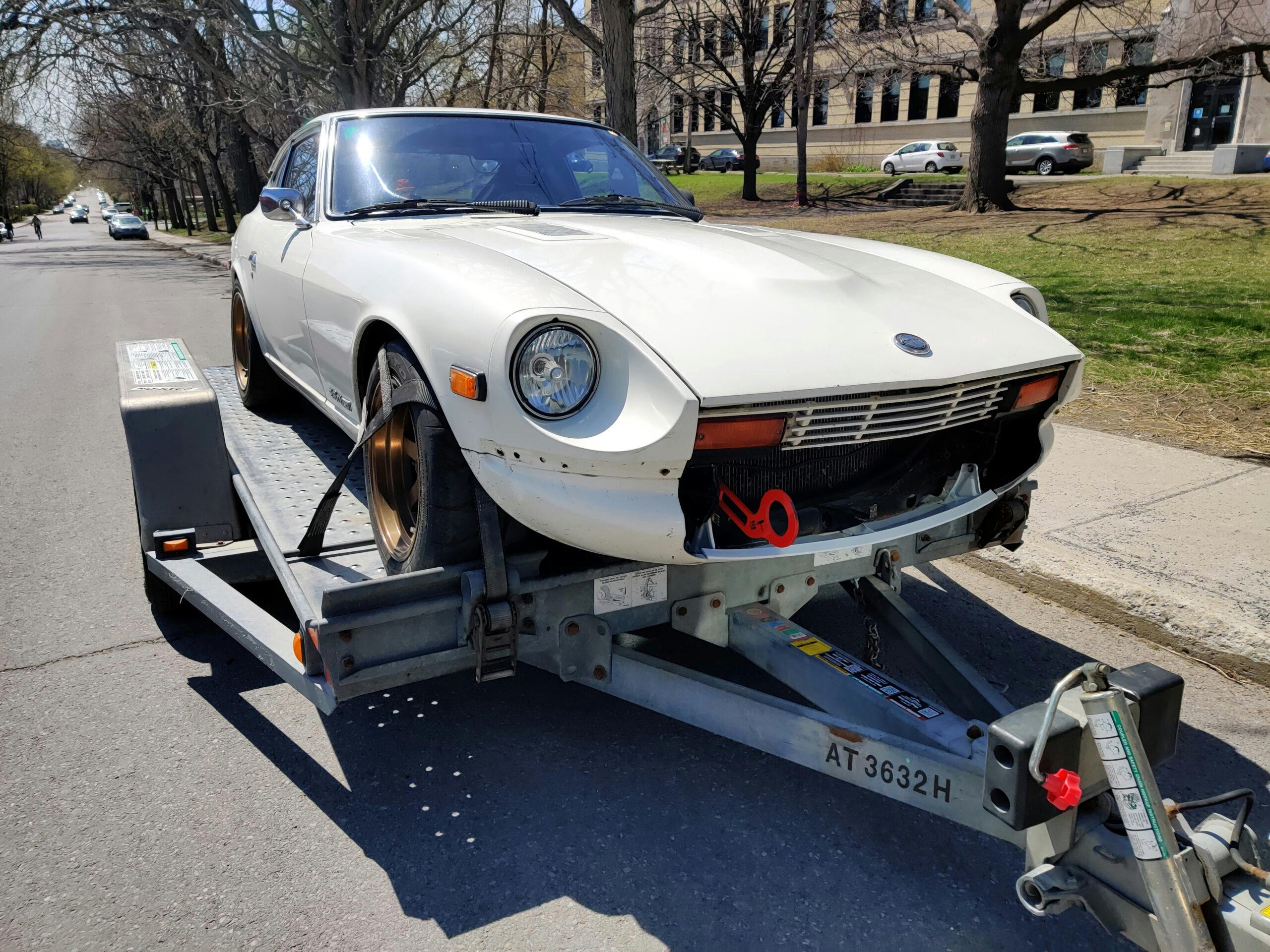

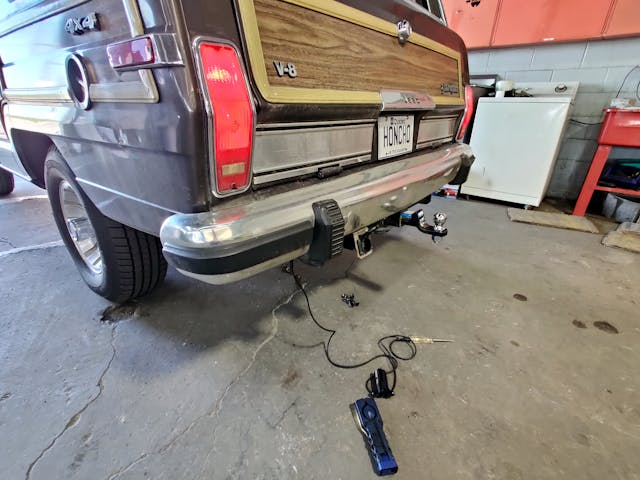
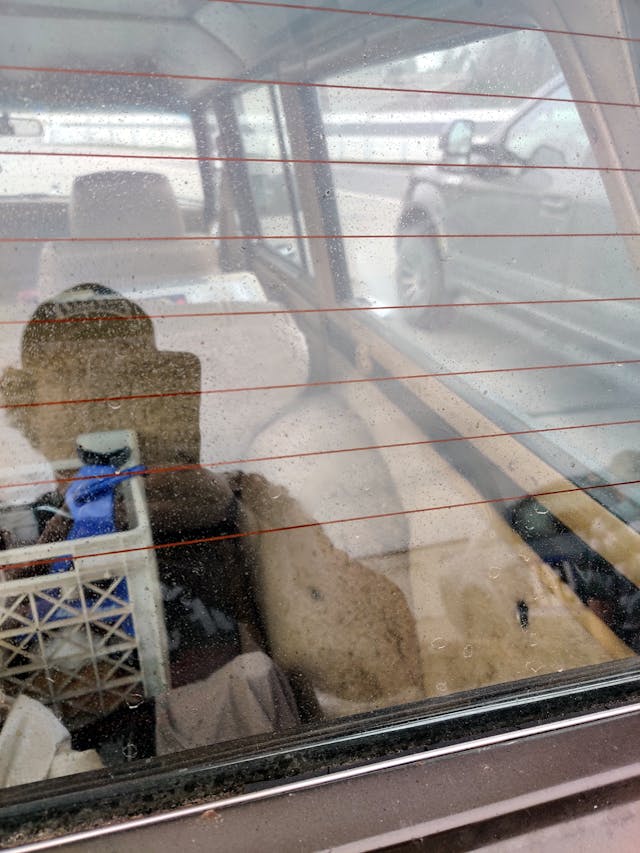

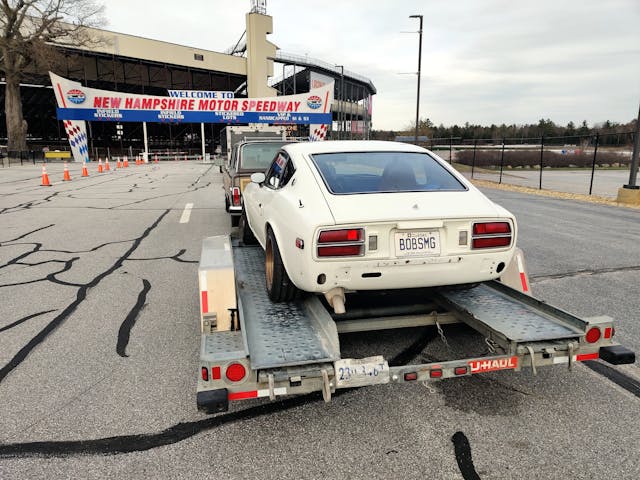

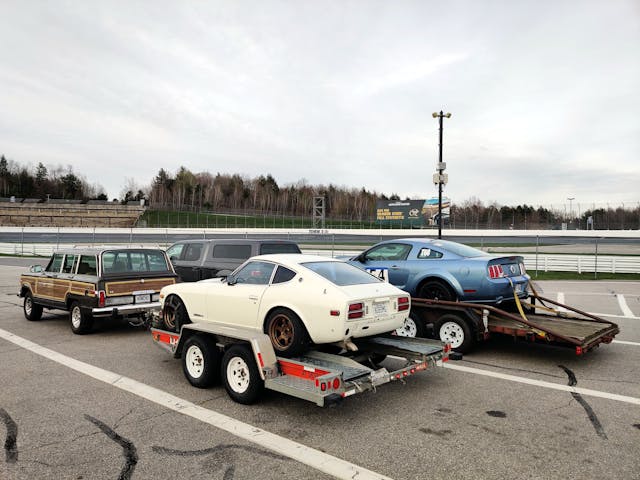
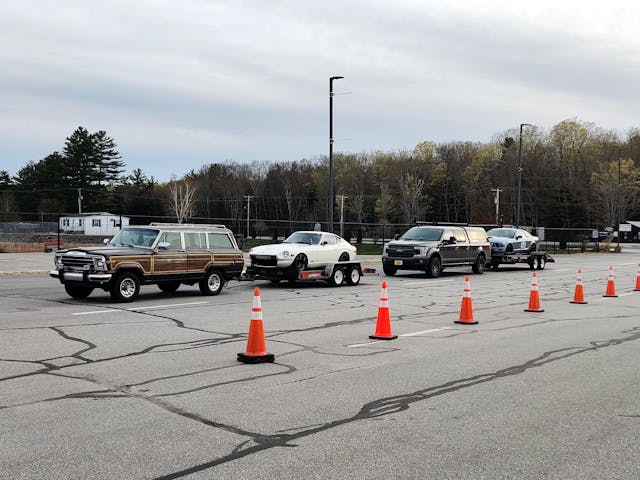
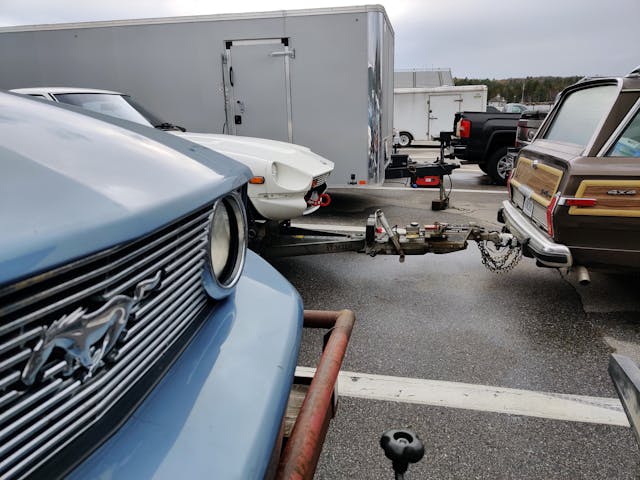

















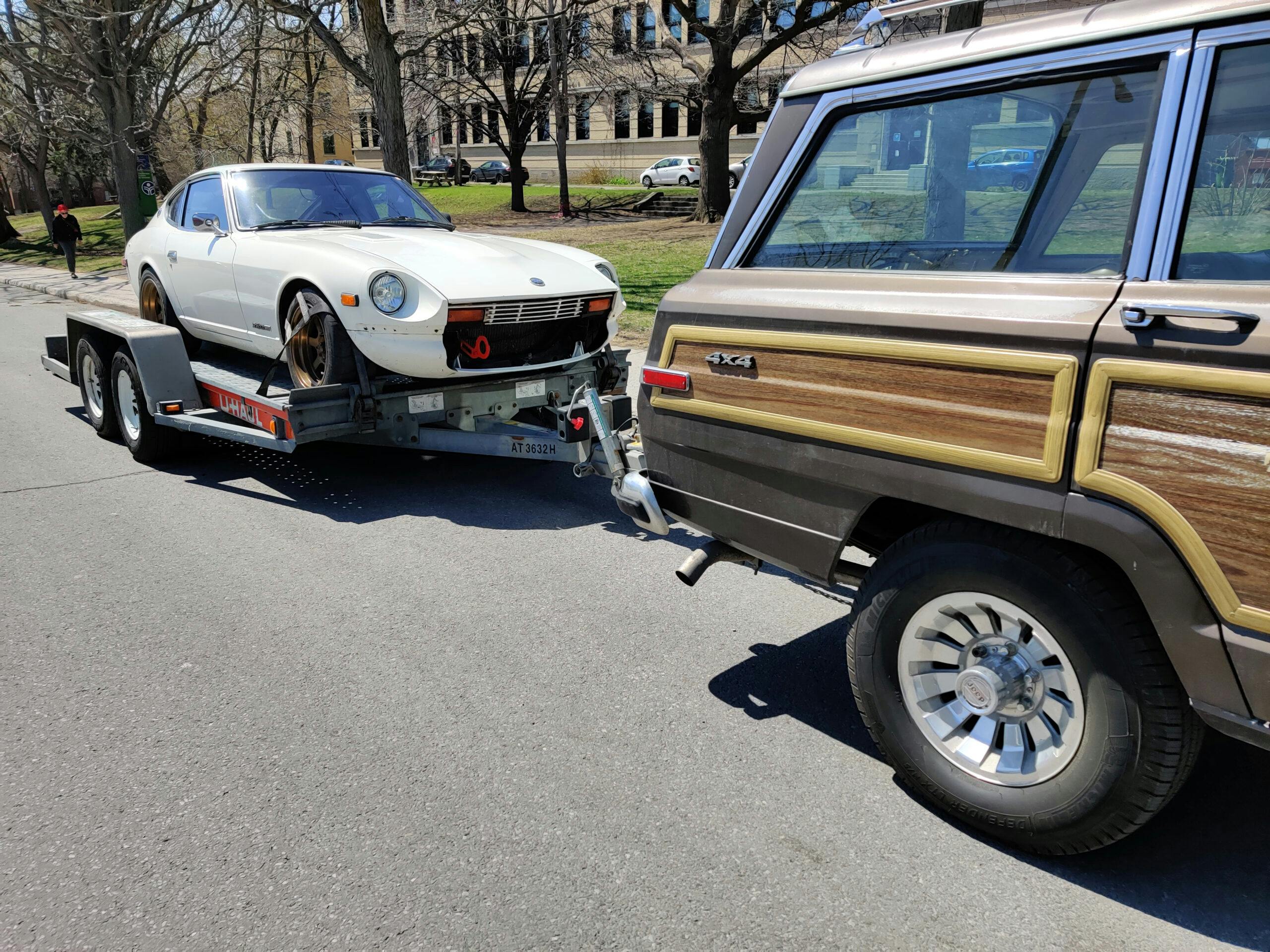
As a former tow truck driver back when beefy chrome bumpers, slings and J-hooks were the norm, we used all manner of wood blocks. From looking at it, could you have put some 6″x6″ wood blocks in front of the front tires to hold the car back 6″ from the nose and shifted it slightly to the rear?
Does your GW have a rear anti-sway bar? They can help with the waggle. You can also air your rear tires up closer to the rated pressure. If you were running 32PSI and the sidewall says max of of 51PSI, you can safely raise it to 35PSI to firm it up a bit. Truck tires with more belts and higher load ratings wouldn’t hurt either.
Your oiling problem sounds like an internal pressure issue. If your PVC is being overwhelmed, that pressure has to go somewhere and it will come out a gasket or seal. A simple fix might be adding a breather to a valve cover though I’m guessing the damage is already done and a seal has been blown.
Wheelbase is very important, but U-Haul trailers are junk. You are not asking too much from the Grand Wagoneer. Get a good aluminum trailer with good tires, sway control, weight distribution bars, electric brakes with a digital brake controller, and you should be good. I’ve towed a lot of trailers with a variety of vehicles, including shorter-wheelbase models. The overall setup is key.
I towed a Neon all over the place with a stock V8 Wagoneer and never had any trouble. It was a limo compared to the years I towed with a Subaru pulling a Subaru. Tongue weight is key. Having an electric brake control at your fingertips is a great stress reliever although I never needed it.
Very interesting and honest read. Well written. Reminds me of my installation of a 364 Buick in a 1935 5-Window Ford. I had very little money so all had to be done with my relatively primitive tools. Only took me the whole summer, 8 hour days. FiIred it up at 3 in the morning. Couldn’t wait!
Surprised that it couldn’t handle the tow though. Probably replacing with heavier springs (not overload) you might have had more success. I replaced the rear springs on a 1972 Dodge Charger with Station Wagon springs to tow a 2-horse trailer. Worked very well. Changed the handling of the Charger completely – in a good way. This was back in 1990 before all the hoopla. Had weight distributing hitch with electric brakes.
Really enjoyed the articles. Actual honest stuff that happens.
First up check the tongue weight. You probably have one of those telescopic scales that slips into the bit where the tow ball sits. If it is too heavy, you may do better by loading the car backwards.
Several of my veterans go into the trailer backwards for better weight distribution. Each car has a paint mark on the trailer floor. You could do the same thing with a tape measure.
Glad you made it back. I feel your pain with regard to all the hard work you put into the jeep to end up being a little disappointed, but I love it and think it came out great. I briefly had a 1960 wagoneer, super cool. Also, New hampshire motor speedway is in my backyard, if you ever need any help in the future let me know!
I recently changed the tires out on my 97 1/2 ton Silverado from 4 ply suv/light pickup tires to load range E LT tires and it made a major difference in it’s towing stability. I have had several white knuckle trips as you have described towing on a heavy old home built car trailer with various vehicles on it. The difference in changing to the 10 ply tires was night and day in directional stability and it made the towing actually enjoyable rather than down right scary. You will lose some of the cushy ride but the increase in stability will be well worth it if you intend to continue using the GW as a tow vehicle. Proper load distribution and tongue weight are important but tires with less sidewall give make a big difference too.
Reality Check: GOOD for you recognizing your project Jeep’s limitations and deciding to stay safe. Enjoy the SJ for the “other” tasks it is good at. Enjoy and Be Safe!
Never compromise when towing. I save my old 2005 Ford F350 Diesel for crazy heavy loads. My Featherlite 14,000 GW trailer will handle my 10,000 pound CAT 259 skid steer and any car at any highway speed. I will never part with them. You need something like that and you can relax and cruise.
This is why old rigs should generally be used for pleasure only, and leave the real work to new, or late-model, tow/hauling vehicles. As long as you are not towing over 7000 or so pounds, I suggest a Tahoe or Suburban; they are built for such work. I have driven one for years; they never shy away from towing near the load limit. And, for most folks, they are far more useful vehicles than an open-bed pickup truck, when not towing. And, a short wheelbase will NOT be a problem! ;<)
If the air bags are plumbed together instead of individually, it will make a sway problem worse. Also I second the consensus that the particular trailer you were using puts far excess tongue weight on any tow vehicle it’s attached to.
It looks to me like the weight of the Z is centered ahead of the axles on the trailer. There are some interesting demonstrations out there for what happens when you shift the weight on a trailer relative to the axles.
https://youtu.be/JeEEC5eVNCk?si=rmVdH8MFYJAeiGCE
In defense of YouHaul trailers, I towed several Mercedes (73 450SLC and 88 560SL) between Paso Robles and Fresno, CA behind a RAM 1500 and a Honda Ridgeline — with no problems. I’m sure each of those cars weighed more than your Z. No sway, no issues at all. Up and down hills, and through curves — no problem. I stayed below 55MPH. And I appreciate YouHaul’s refusal to let renters tow trailer without verifying everything works properly — although, at the time, I was quite irked that they didn’t like my (sketchy) homemade 7-pin to 4-pin wiring adaptor, and I had to buy one of theirs.
Years ago (early 2000s) a friend who owned a body shop bought a full sized Bronco for a great price. Did a new paint job, newly upholstered leather seats, had a mechanic go through all the mechanicals. The 351 was still in great condition, as was the three speed auto. Four wheel drive needed a little work, but nothing major. He planned on towing his 22′ center console boat with twin 125 hp outboards. He too had air helper springs in the back. Towed it the first time, and boy was he mad! He’d spent a lot to refurbish the Bronc only to find it sucked as a tow rig. I suggested he buy a load leveler hitch. He said he wasn’t going to waste any more money. My reply was what’s another $300 or so at this point? Saw him a couple weeks later and he was happy! He’d decided it wouldn’t hurt if he “wasted” a few more hundred on something that might actually work… and it did! So buy a car trailer with electric brakes and a load leveler hitch. The trailer will also be a bit lighter than the U-Haul heavy duty beast.
I tow a 30′ bumper pull travel trailer with my 2003 Expedition — the standard short wheelbase model. It sucked at first. Sumo spring spacers and a 1.25″ rear sway bar (stock trailer tow package still only had a 1/2″ sway bar!!), along with the load leveler hitch, solved the twitchy rear (of course it’s an IRS…). My trailer is 7200 pounds empty and the tow rating on the Expy is 8400 pounds (4×4 model), so I’m at or a little over the tow rating. I don’t carry water in the tank since I don’t boon-dock, so that helps.
Speaking of tow rating, you’ve actually increased the Waggies rating by improving the rear suspension, regearing, and increasing engine power.
Also, I don’t know about the 4L80, but the 03 Expy owners manual says to tow in OD. Most modern OD trannys do. It will drop out of OD as needed, just like any other gear. When OD autos first came out the OD part wasn’t strong enough for towing, but yours should be. Get a look at the owners manual from the donor truck and see what it says. Towing in the mountains you probably want to not use OD, but I do. It will go into OD going down a hill, drop out going up. Did the same with my 03 Tundra (and a smaller camper, but still at recommended limit once loaded to go). No issues with either. You have a much newer LS and trans, I believe, and should be fine towing in OD EXCEPT in cases where you want engine braking. I towed in the Rockies. I did pull the selector down to “3” (no OD) when going down the Saluda Grade on I-40 (near Asheville, NC), and another long incline I encountered, but most of the time it stays in OD.
I really, really appreciate all of the advice and kind words in these comments. It’s great to hear people speaking about their experiences with towing, older rigs, and the solutions they’ve tried and what works/what doesn’t. Thank you to all.